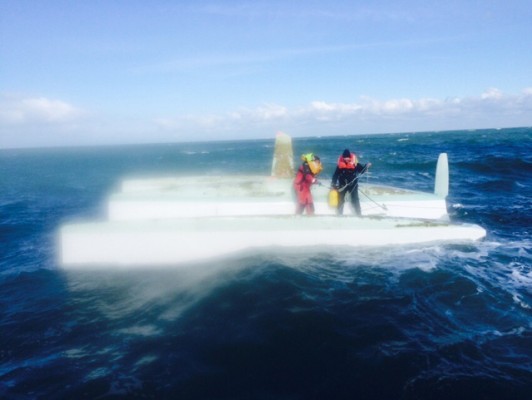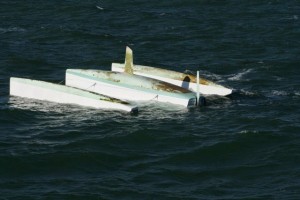A heavily pregnant woman and her partner were airlifted to hospital after their trimaran capsized one nautical mile off Dungeness Point, Kent.
Dover Coastguard received a report from a member of the public at 3pm on Saturday that two people were in the water, clinging to the upturned hull.
The Coastguard contacted the HM Customs cutter, ‘Valiant’ which was already out on the water. They were able to get to the vessel within minutes and as they neared it, spotted a red flare which had been fired.
The cutter stood by the vessel, ensuring the safety of those in the water and marking the upturned hull.
Meanwhile the Coastguard had requested the Dungeness RNLI lifeboat to launch and the couple were picked up from the water and brought to shore, then taken to William Harvey Hospital by the rescue helicopter from RAF Watisham.
Coxswain Stuart Adams in command of the Dungeness RNLI vessel established that both casualties were wearing lifejackets but that the female was 37 weeks pregnant and both people were very wet and cold, but otherwise unharmed.
Both casualties scrambled onto the lifeboat, with the help from the RNLI crew.
The RNLI lifeboat ferried them into the beach to the RNLI shore crew and Dungeness Coastguard. After assessment by the waiting ambulance crew, they were airlifted by the RAF helcopter 125, which was standing by, to the William Harvey Hospital in Ashford.
The customs vessel Valiant stood by the upturned craft until the RNLI lifeboat returned and towed the stricken craft into the beach at Dungeness.
Bob Giles, Dover Coastguard Watch Manager said: ‘The couple were thrown into the water after their vessel capsized.
‘Both were wearing lifejackets and the man, ensured that his partner was safe, then tied a rope around himself and dived under the vessel to retrieve a flare so that he could alert rescuers to their position.
‘Because they had AIS (automatic identification system) on board they were easy to locate and so were rescued quickly.
‘The member of the public who made the first call to the Coastguard did exactly the right thing by calling 999 and asking for the Coastguard.
‘It meant that we were able to get rescuers to the scene within minutes of the vessel capsizing.’





